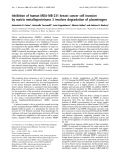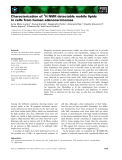
Biochemistry of cancer
-
P-glycoprotein (Pgp), a membrane pump often responsible for the multidrug resistance of cancer cells, undergoes conformational changes in the presence of substrates/modulators, or upon ATP depletion, reflected by its enhanced reactivity with the UIC2 monoclonal antibody. When the UIC2-shift was elicited by certain modulators (e.g. cyclosporin A or vinblastine, but not with verapamil or Tween 80), the subsequent binding of other monoclonal anti-Pgp Ig sharing epitopes with UIC2 (e.g. MM12.10) was abolished [Nagy, H., Goda, K., Arceci, R., Cianfriglia, M., ´ Mechetner, E. & Szabo Jr, G.
 6p
6p  system191
system191
 01-06-2013
01-06-2013
 62
62
 7
7
 Download
Download
-
Department of Biochemistry, Eotvos Lorand University, and 2Biotechnology Research Group of the Hungarian Academy of Sciences, ´ ´ ´ ´ Pazmany setany 1/C, Budapest, Hungary The molecular mechanism of the autolysis of rat a-chymotrypsin B was investigated. In addition to the two already known autolytic sites, Tyr146 and Asn147, a new site formed by Phe114 was identified. The former two sites and the latter one are located in the autolysis and the interdomain loops, respectivel
 9p
9p  system191
system191
 01-06-2013
01-06-2013
 36
36
 4
4
 Download
Download
-
Departamento de Fisiologıa de la Nutricion, Instituto Nacional de Ciencias Medicas y Nutricion ‘Salvador Zubiran’, Mexico; ´ ´ ´ ´ ´ Departamento de Patologıa Experimental, Instituto Nacional de Ciencias Medicas y Nutricion ‘Salvador Zubiran’,Mexico; 3Department of Biochemistry, Wake Forest University Medical Center, Winston-Salem, North Carolina, USA Branched chain amino-acid aminotransferase (BCAT) activity is present in fetal liver but the developmental pattern of mitochondrial BCAT (BCATm) expression in rat liver has not been studied.
 8p
8p  system191
system191
 01-06-2013
01-06-2013
 47
47
 6
6
 Download
Download
-
A splicing factor SF2/ASF is a natural substrate for the kinase activity of human topoisomerase I. This study demonstrates that SF2/ASF inhibits DNA cleavage by human topoisomerase I induced by the anti-cancer agent camptothecin. The inhibition is independent of the phosphorylation status of SF2/ASF. We show that the inhibition did not result from binding of SF2/ASF to DNA that would hinder interactions between topoisomerase I and DNA. Neither it was a consequence of a loss of sensitivity of the enzyme to camptothecin.
 7p
7p  research12
research12
 01-06-2013
01-06-2013
 39
39
 5
5
 Download
Download
-
Mucin glycoproteins on breast cancer cells carry shortened carbohydrate chains. These partially deglycosylatedmucin 1 (MUC-1) structures are recognized by the monoclonal antibody SM3, which is being tested for its diagnostic utility. We used NMR spectroscopy to analyze the binding mode and thebindingepitopeof peptideandglycopeptideantigens to the SM3 antibody. The pentapeptide PDTRP and the glycopentapeptide PDT(O-a-D-GalNAc)RP are known lig-ands of the monoclonal antibody.
 12p
12p  research12
research12
 29-04-2013
29-04-2013
 40
40
 3
3
 Download
Download
-
Matrix metalloproteinase (MMP)-3 inhibited human MDA-MB-231 breast cancer cell invasion through recon-stituted basement membranein vitro. Inhibition of invasion was dependent upon plasminogen and MMP-3 activation, was impaired by the peptide MMP-3 inhibitor Ac-Arg-Cys-Gly-Val-Pro-Asp-NH2 and was associated with: rapid MMP-3-mediated plasminogen degradation to microplas-minogen and angiostatin-like fragments;
 8p
8p  research12
research12
 23-04-2013
23-04-2013
 35
35
 3
3
 Download
Download
-
As one of the most important families of non-natural poly-mers with the propensity to form well-defined secondary structures, theb-peptides are attracting increasing attention. The compounds incorporatingb-amino acid residues have found various applications in medicinal chemistry and biochemistry.The conformational pool ofb-peptides com-prises several periodic folded conformations, which can be classified as helices, and nonpolar and polar strands.The latter two are prone to form pleated sheets.
 10p
10p  tumor12
tumor12
 20-04-2013
20-04-2013
 30
30
 4
4
 Download
Download
-
Much of the basic biochemistry of antiplasmin was described more than 20 years ago and yet it remains an enigmatic member of the serine protease inhibitor (serpin) family. It possesses all of the characteristics of other inhibitory serpins but in addition it has unique N- and C-terminal exten-sions which significantly modify its activities. The N-terminus serves as a substrate for Factor XIIIa leading to crosslinking and incorporation of antiplasmin into a clot as it is formed.
 6p
6p  fptmusic
fptmusic
 12-04-2013
12-04-2013
 29
29
 2
2
 Download
Download
-
Human glutamate carboxypeptidase II (GCPII) is a co-catalytic metallopeptidase and its putative catalytic domain is homologous to the aminopeptidases fromVibrio proteolyticus and Streptomyces griseus.In humans, the enzyme is expressed predominantly in the nervous system and theprostate.Theprostate form, termedprostate-specific membraneantigen, is overexpressed inprostate cancer and is used as a diagnostic marker of the disease.II
 9p
9p  dell39
dell39
 03-04-2013
03-04-2013
 39
39
 4
4
 Download
Download
-
Tumour cells are often sensitized by interferons to the effects of tumour necrosis factor-a-related apoptosis-inducing ligand (TRAIL). We have demonstrated previously that TRAIL has an inhibitory effect on protein synthesis [Jeffrey IW, Bushell M, Tilleray VJ, Morley S & Clemens MJ (2002) Cancer Res62, 2272–2280] and we have therefore examined the consequences of prior interferon-atreatment for the sensitivity of transla-tion to inhibition by TRAIL.
 11p
11p  inspiron33
inspiron33
 25-03-2013
25-03-2013
 34
34
 3
3
 Download
Download
-
Hepoxilins are biologically relevant epoxy-hydroxy eicosanoids synthesized through the 12S-lipoxygenase (12S-LOX) pathway of the arachidonic acid (AA) metabolism. The pathway is bifurcated at the level of 12S-hydro-peroxy-eicosatetraenoic acid (12S-HpETE), which can either be reduced to 12S-hydro-eicosatetraenoic acid (12S-HETE) or converted to hepoxilins.
 10p
10p  galaxyss3
galaxyss3
 19-03-2013
19-03-2013
 21
21
 1
1
 Download
Download
-
Papillomaviruses are small DNA tumor viruses that infect mammalian hosts, with consequences from benign to cancerous lesions. The Early pro-tein 2 is the master regulator for the virus life cycle, participating in gene transcription, DNA replication, and viral episome migration.
 11p
11p  galaxyss3
galaxyss3
 19-03-2013
19-03-2013
 33
33
 3
3
 Download
Download
-
Cyclin dependent kinase 4 is a key regulator of the cell cycle and its activ-ity is frequently deregulated in cancer. The activity of cyclin dependent kinase 4 is controlled by multiple mechanisms, including phosphorylation of tyrosine 17.
 11p
11p  galaxyss3
galaxyss3
 07-03-2013
07-03-2013
 30
30
 4
4
 Download
Download
-
Matrix metalloproteinase-9 (MMP-9) displays a preference for a broad range of substrates including extracellular matrix proteins and cytokines. MMP-9 plays an important role in physiological processes, as well as in inflammatory diseases and numerous cancers.
 13p
13p  media19
media19
 05-03-2013
05-03-2013
 34
34
 1
1
 Download
Download
-
Epidermal growth factor receptor (EGFR)-mediated signal transduction is often hyperactivated in tumour cells and therefore considered a promising target for cancer therapy. A number of computational models have been developed which describe the pathway in great detail.
 13p
13p  media19
media19
 04-03-2013
04-03-2013
 39
39
 3
3
 Download
Download
-
A major contributing factor to the development of breast cancer is decreased functional expression of breast cancer susceptibility gene 1, BRCA1. Another key contributor to tumorigenesis is hypoxia. Here we show that hypoxia increased the nuclear localization of BRCA1 in MCF-7 and MDA-MB-468 human breast cancer cell lines without changing its steady-state expression level.
 10p
10p  media19
media19
 04-03-2013
04-03-2013
 49
49
 2
2
 Download
Download
-
Breast cancer cells exhibit excessive proteolysis, which is responsible for extensive extracellular matrix degradation, invasion and metastasis. Besides other proteases, lysosomal cysteine protease cathepsin B has been impli-cated in these processes and the impairment of its intracellular activity was suggested to reduce harmful proteolysis and hence diminish progression of breast tumors.
 12p
12p  media19
media19
 04-03-2013
04-03-2013
 50
50
 2
2
 Download
Download
-
X-Linked inhibitor of apoptosis protein (XIAP) is a member of the inhibitor of apoptosis protein family that is overexpressed in human can-cers. There is great interest in the development of XIAP inhibitors, which are predicted to promote apoptosis in cancer cells and thus have therapeutic potential.
 11p
11p  vinaphone15
vinaphone15
 28-02-2013
28-02-2013
 29
29
 2
2
 Download
Download
-
The hypothalamic decapeptide gonadotropin-releasing hormone (GnRH) is well known for its role in the control of pituitary gonadotropin secretion, but the hormone and receptor are also expressed in extrapituitary tissues and tumor cells, including epithelial ovarian cancers.
 16p
16p  vinaphone15
vinaphone15
 28-02-2013
28-02-2013
 31
31
 3
3
 Download
Download
-
Magnetic resonance spectroscopy studies are often carried out to provide metabolic information on tumour cell metabolism, aiming for increased knowledge for use in anti-cancer treatments. Accordingly, the presence of intense lipid signals in tumour cells has been the subject of many studies aiming to obtain further insight on the reaction of cancer cells to external agents that eventually cause cell death.
 14p
14p  vinaphone15
vinaphone15
 27-02-2013
27-02-2013
 28
28
 3
3
 Download
Download
CHỦ ĐỀ BẠN MUỐN TÌM
































